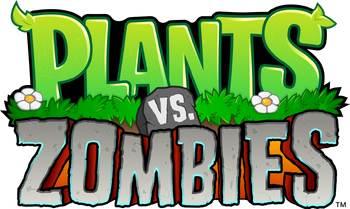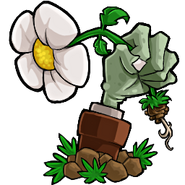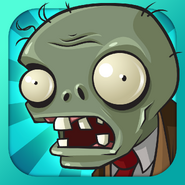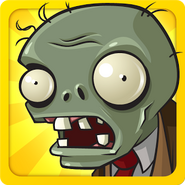

Microsoft Windows / macOS
Early Version
October 28, 2008 (delayed)
Final Version
NA: May 5, 2009
JP: September 17, 2009
EU: October 3, 2009
AU: April 28, 2010
Game of the Year Edition
NA: July 11, 2010
JP: November 18, 2010
EU: February 18, 2011
iOS
NA: February 15, 2010 (iPhone and iPod touch)
March 31, 2010 (iPad)
Xbox Live Arcade
NA: September 8, 2010 (Xbox 360)
November 12, 2015 (Xbox One Compatible Support)
Nintendo DS
NA: January 18, 2011
EU: May 6, 2011
PlayStation Network
NA: February 8, 2011
PAL: February 9, 2011
DSiWare
NA: March 14, 2011
PAL: May 6, 2011
Android
NA: May 31, 2011 (Amazon)
December 14, 2011 (Google Play)
Window Phone
NA: June 22, 2011
PlayStation Vita
February 22, 2012
BlackBerry 10
NA: January 30, 2013
[1] Popcap Website
[2] (shockwave games)
[3] (Xbox)
[4] (Flash version[Archived])
Plants vs. Zombies (abbreviated as PvZ or PvZ1 and also known as the original Plants vs. Zombies) is a tower defense video game developed and originally published by PopCap Games and it is the first installment in the Plants vs. Zombies series. The game involves homeowners who use a variety of different plants to prevent waves of zombies from entering their houses and "eating their brains".
It was first going to release on October 28, 2008, back when it was titled Bloom & Doom, but as an early version, and it got delayed. It was first released on May 5, 2009, and it originally (and initially) was made available on Steam for Microsoft Windows and macOS. An iPhone version for iOS was released on February 15, 2010, and an HD version for the iPad was released on March 31, 2010. Furthermore, both the original Windows and Mac version of the game have been re-released with additional content in the Game of the Year Edition on July 11, 2010. An extended Xbox Live Arcade version introducing new gameplay modes and features was released on September 8, 2010. PopCap released a Nintendo DS version on January 18, 2011 with content unique to the platform. The PlayStation 3 version was released in February 8, 2011 also with added new co-op and versus modes found in the Xbox 360 version. An Android version of the game was released on May 31, 2011 on the Amazon Appstore, while it was also released to the Android Market (now Google Play) on December 14, 2011. On February 16, 2012, a version was released for BlackBerry PlayBook. Later, a BlackBerry smartphone version of the game was released on January 2013 following the launch of BlackBerry 10. In November 13, 2014, a free ad-supported version of the game was released for iOS and Android.
The game received a positive response from critics and was nominated for multiple Interactive Achievement Awards, alongside receiving praise for its musical score. The game is followed by a sequel, Plants vs. Zombies 2, which was released on July 9, 2013, in Australia and New Zealand, then it was released worldwide on August 15, 2013.



![]()
![]()
![]()

![]()
![]()
![]()
![]()
An all-new action-strategy game from PopCap, makers of Bejeweled and Peggle!
Zombies are invading your home, and the only defense is your arsenal of plants! Armed with an alien nursery-worth of zombie-zapping plants like peashooters and cherry bombs, you'll need to think fast and plant faster to stop dozens of types of zombies dead in their tracks. Obstacles like a setting sun, creeping fog and a swimming pool add to the challenge, and with five game modes to dig into, the fun never dies!
Get ready to soil your plants in an all-new action-strategy game from PopCap! A mob of fun-loving zombies is about to invade your home, and your only defense is an arsenal of 49 zombie-zapping plants. Use peashooters, wall-nuts, cherry bombs and more to mulchify 26 types of zombies before they can reach your front door. Each zombie has its own special skills, so you’ll need to think fast and plant faster to combat them all. But be careful how you use your limited supply of greens and seeds… as you battle the fun-dead, obstacles like a setting sun, creeping fog and a swimming pool add to the challenge. And with five game modes to dig into, the fun never dies!
In Plants vs. Zombies, players place different types of plants and fungi, each with their own unique offensive or defensive capabilities, around a house, in order to stop a horde of zombies from reaching their house. The playing field is divided into 5 to 6 horizontal lanes, and with rare exceptions, a zombie will only move towards the player's house along one lane (the main exception is if it has bitten a garlic, causing it to move to another lane). Planting costs "sun", which can be gathered for free (a bit slowly) during daytime levels and by planting certain plants or fungi. Most plants can only attack or defend against zombies in the lane they are planted in. In later levels, players can purchase upgrades with different offensive and defensive abilities.
The game uses several different level types and layouts. The game starts out in a front yard and progresses to nighttime levels, where the gameplay is more challenging without any replenishing sun unless specific plants are used. Other levels feature the backyard, with a pool added. The next levels are nighttime pool levels (where fog fills the right half of the screen except when specific plants are used), a lightning storm level in pitch black (except when illuminated by occasional flashes of lightning), and rooftop levels (on the final level, the player must face a huge robot operated by a mad scientist zombie known as Dr. Zomboss). At set points throughout the game, the player is either warned through a letter by zombies or addressed by Crazy Dave to prepare for an ambush, where the game takes on a bowling style, using Wall-nuts to bowl down zombies, or a modified version of regular levels, where random plant types come upon a small selection, and the player can use the plants without spending sun.
The player starts with a limited number of seed pack types and seed pack slots that they can use during most levels. The number of slots can be increased through purchases with in-game money. At the start of a level, the player is shown the various types of zombies to expect and given the opportunity to select which seed packs to take into the level. Several plants are nocturnal, such as mushrooms, having a lower sunlight cost, and are ideal for nighttime levels. Certain plants are highly effective against specific types of zombies, such as the Magnet-shroom, which can remove metallic items from a zombie, such as helmets, buckets, ladders, and pogo sticks.
The zombies also come in a number of types that have different attributes, in particular, speed, damage tolerance, and abilities. Zombies include those wearing makeshift armor, those who can jump or fly over plants, and a dancing zombie able to summon other zombies from the ground. At various points, the player will be inundated with a huge wave of zombies.
If a zombie reaches the end of a lane, a lawnmower will shoot forward and destroy all the zombies in that lane. However, if a zombie reaches the end of that same lane for a second time, it will reach the player's house. When this happens, the music changes and the other plants and zombies stop moving while that zombie enters the house. Crunching sounds will be heard, accompanied by a big "NO!" scream and a message saying "The zombies ate your brains!", causing the loss of a level. This eventually displays the Game Over dialog box along with an option to return to the main menu at the upper-right side of the screen, however, the Game Over screen may differ between platforms.
The primary game mode is Adventure Mode in which the player can earn money to spend at an in-game store to buy new seed packets and other bonuses. There are also Mini games and puzzles. In the Xbox Live Arcade, PlayStation Network, and Nintendo DS versions, there is also a co-op mode, as well as 2 player Mini games and a Versus mode (but not in the Nintendo DS version).
The adventure mode consists of 6 different areas and 50 different area levels (each area contains 10 levels, except Roof where nine of the levels are set in daytime (5-1 to 5-9) while Level 5-10 is Night Roof). They are shown with the area number first, followed by the level number (i.e 1-10) in the game. Each level in this mode has a certain amount of flags and one final wave. The adventure mode is the first game mode and is also the main mode. Mini games are unlocked from here.
Mini games are unlocked during the adventure mode and are mostly for fun. Some of the minigames are inspired by earlier PopCap games.
Puzzles consist of 18 levels from 2 different "modes", Vasebreaker, where you break vases that either contains a plant seed or a zombie or some sun for cherry bombs, and I, Zombie, where you create zombies to destroy cardboard cutouts of plants.
Survival Mode is the second largest game mode in Plants vs. Zombies. It involves two difficulties as hard and normal and also has different areas. Each normal round has 5 flags and each hard round has 10 flags. It also has an endless streak level as the final level. Survival is the last game mode in the game itself.
There is also a page of canceled mini-games called the Limbo Page which can be accessed using Cheat Engine.
The game also features a Zen Garden, where players can care for plants they previously purchased from Crazy Dave's Twiddydinkies. Players can also buy other Zen Garden areas for different plants. Fertilizer, water, and bug spray are necessary for a plant to grow. Plants will only grow when the game has been running for enough time.
Plants vs. Zombies director George Fan intended on balancing the game between a "gritty" game and a "sickeningly cute" game. Strong strategic elements were included to appeal to more experienced gamers, while keeping it simple to appeal to casual gamers, without many tutorials. He was inspired to make it a tower defense game after thinking both of a more defense-oriented version of a previous title of his, Insaniquarium, and playing some Warcraft III tower defense mods. While he was looking at the towers in Warcraft III, he felt that plants would make good towers. He wanted to bring something new to the genre with Plants vs. Zombies, and he found common tower defense gameplay elements such as mazing and juggling to be too awkward, causing him to use the five- and six-lane set-ups that were used in the final version. The game was initially going to be called Weedlings, but as the tower defense concept took off and the personality of the game as a whole evolved, the title was later changed.
George Fan included elements from the trading card game, Magic: The Gathering, which he had played with his girlfriend Laura Shigihara. Showing her how to customize their card decks inspired him to design Plants vs. Zombies with seed packets rather than his original idea of using a conveyor belt that produced randomly selected plants, due to the greater complexity of the seed packet method. Another influence on Plants vs. Zombies besides Warcraft III and Insaniquarium was Tapper, crediting the use of five lanes to this game. Various members of PopCap Games contributed to the development of Plants vs. Zombies through an internal forum where they gave feedback.
Some of the characteristics that defined Insaniquarium influenced the development of Plants vs. Zombies. Players advance in a similar pace by receiving new plants. Also, the way plants are chosen at the beginning of each level was derived from the way pets are chosen in Insaniquarium. Other inspiration for the game's mechanics came from the film Swiss Family Robinson, especially where the family defends against pirates. This was the inspiration for the Potato Mine; Fan stated that it was satisfying to watch a zombie step on the mine, being defeated and covered in mashed potatoes.
The team wanted to bring back the aliens from Insaniquarium, but in the end, they were changed to zombies, which players could react to more easily because of how slowly they moved. Fan's favorite zombie was the Pole Vaulting Zombie, due to the hilarity involved when a player encounters it for the first time, using a specific example where a player tries to block it with the Wall-nut, only to have the zombie jump over it.
During development, it was discovered that newcomers to the genre of real-time strategy may have a hard time learning the concept behind sun collection. So, the price of the income generating Sunflowers was dropped from 100 to 50 to encourage players to buy them over the attacking Peashooter. As a result, the balance between plants and zombies had to be restructured—a move that Fan said was definitely worth the effort. Programmers focused on Adventure mode for much of the first year of development. Upon finishing some items ahead of schedule, one of the programmers, Tod Semple, began working on ideas that would later be used for the minigame section. Some ideas for the puzzle mode section would later be tweaked and moved into adventure mode; "Vasebreaker" and "I, Zombie", for example, came from single-level minigame concepts. During testing, Fan found that minigame and puzzle modes seemed to detract from the focus on Adventure mode, so some of the additional modes and minigames were locked requiring advancement within adventure mode to become unlocked.
George Fan stated that every game he worked on had only him designing the prototype, adding that he used to draw a lot before he made games, where he made pixel art. The final designs of the zombies and the first plants are similar to how they were initially. After searching for an artist, they discovered Rich Werner, who Fan thought clicked with what he intended for the design. He attributed the intrigue of the design to its animation scheme; Tod Semple suggested that they animate it in Flash and export it into the game. Fan worried that this would look like it was cut out from paper, and would resemble South Park too much, but was satisfied in the end, attributing this to Semple and Werner's talents.
George Fan was most proud of the Tall-nut, Torchwood, and Cob Cannon plants. He explained that the Tall-nut has character, citing its "determined gaze" and how it sheds a single tear when hurt. Laura Shigihara could not stand to see this and protected it with a protective plant called a Pumpkin, which can protect plants inside it. He felt that the Torchwood – which gives Peashooters flaming ammunition – required players to think of how plants interacted with each other. Another favorite plant of Fan's was the Squash, due to how its name suggested its purpose; to squash things. A plant was proposed that is similar to the defensive item Umbrella Leaf, which would be planted above other plants to protect them from bungee zombies and catapult zombies. However, it was difficult to visualize their positions.
Plants vs. Zombies uses many cultural references in its names of stages and others. The gravestones' inscriptions ("Expired", "Ceased to Exist", "Just Resting", etc.) were taken from Monty Python's Dead Parrot Sketch. Four of the mini-games—"Zombiquarium", "Beghouled", "Beghouled Twist", and "Whack a Zombie"—are a reference from four other PopCap games: Insaniquarium, Bejeweled, Bejeweled Twist, and Hammer Heads Deluxe respectively. Two levels in "Vasebreaker" puzzles, "Scary Potter" and "Ace of Vase", take their names from Harry Potter and Ace of Base. Similarly, the "I, Zombie" (a reference to Isaac Asimov's I, Robot) puzzles have levels called "Dead Zeppelin" (resembling Led Zeppelin) and "All your brainz r belong to us" (a play on the gaming meme "All your base are belong to us"). The name of the Torchwood plant is a reference to Doctor Who and its spin-off show Torchwood. Originally, the dancing zombie resembled Michael Jackson from the short film Thriller. Though the Jackson-inspired zombie was present in the game before Jackson's death, the estate of Michael Jackson objected to its inclusion more than a year after his death; PopCap agreed to remove the Jackson-inspired zombie and replaced it with a more generic disco-dancing one for all future patches and releases of the game. A "disclaimer" in the game's almanac states "Any resemblance between Dancing Zombie and any persons living or dead is purely coincidental." Some Plants vs. Zombies advertisements parody controversial Evony ads, showing a drooling zombie instead of a voluptuous woman.
A planned name was Lawn of the Dead, a pun on the title of the George A. Romero zombie film Dawn of the Dead. The development team created a video that was sent to Romero to ask permission to use the name, but Romero would not give it. It was then that the development team came up with the name Plants vs. Zombies. It spent three years in development and was released for the PC on May 5, 2009. Since it was released, it has been announced for multiple platforms, including PlayStation 3's PlayStation Network, Xbox 360's Xbox Live Arcade digital distribution service, Nintendo DS, Android, and iOS.
Plants vs. Zombies itself was referenced in "The Passing" campaign of Valve's fellow zombie game Left 4 Dead 2, in which the player can stumble upon in-game graffiti attributed to the character of Crazy Dave. A five-level quest chain culminating in a quest entitled "Lawn of the Dead" in the massively multiplayer online game World of Warcraft: Cataclysm is based on Plants vs. Zombies, using Warcraft elements to recreate the gameplay. Blizzard Entertainment had contacted PopCap about the inclusion, and Laura Shigihara was able to record some new music for the Warcraft version of the game.
David Blazing, known within the game as "Crazy Dave", serves as a narrator and an instructor during Adventure Mode, introducing the player to certain levels and explaining some of the mini-games and bonus levels. He is later abducted by a Bungee Zombie on level 5–10 right before he can tell the player Dr. Zomboss' weaknesses, and reappears during Sunflower's rendition of "Zombies on your Lawn" after Dr. Zomboss's defeat at the end of the game. He has a shop known as "Crazy Dave's Twiddydinkies" that he runs from the back of his car once the player finds his car keys after Level 3–4. He sells several plant upgrades, extra defenses, and Zen Garden items. Crazy Dave's notable features include a rugged beard and a pot always worn on his head, as well as his signature babbling speech.
Dr. Edgar George Zomboss is the main antagonist and the leader of the zombies in Plants vs. Zombies, and reappears in the sequel, Plants vs. Zombies 2: It's About Time. He is battled on the Night Roof during Level 5–10 as the final boss in Plants vs. Zombies. The name "Zomboss" is a portmanteau of the words "Zombie" and "Boss", meaning "Zombie Boss", while the Zombot, the machine used by Dr. Zomboss in the game, is the portmanteau of the words "Zombie" and "Robot", meaning "Zombie Robot".
According to an interview with George Fan, Dr. Zomboss' middle name "George" was not intended to be named after him, and was only accepted since "it sounded like a great middle name for a zombie overlord boss character."
The soundtrack for Plants vs. Zombies was composed by Laura Shigihara. It borrows elements from the pop music genre, as well as console chiptunes. Before the inception of Plants vs. Zombies, Director George Fan asked Laura if she would like to compose the music for his next title after following her for some years. She accepted, owing to his creativity. Shigihara described the music as "macabre, yet goofy". Using the night stage as an example, she used a combination of "Big Band" and swing beats with "several haunting and serious melodies". The songs "Loonboon" and "Brainiac Maniac" were written towards the end of production. The song "Ultimate Battle" also appears in the game Melolune. She stated that these were reactionary songs that she wrote to fit the feel of the game after having played through it twice. She tried to make the game have a Danny Elfman feel to it while mixing in melodic tunes and funky beats. She describes a song early in the game, which uses marching band percussion and swing beats. She described another one which used techno beats with organic sounds. Shigihara also composed and performed the music video shown during the credits of the game, titled "Zombies on Your Lawn".
Plants vs. Zombies has received a positive reception from critics, garnering an aggregate score of 87/100 from Metacritic and an 88% from GameRankings.
IGN editor Andy J Kolozsy commented that it featured a lot more content than other games in the genre, as well as praising its addictive nature. However, the DS version was criticized for its lower quality graphics and expensive price point. GameSpot editor Chris Watters praised the design of the plants and zombies, as well as the visuals and its overall value. However, he found fault in the learning curve. 1UP.com editor Alice Liang found the game enjoyable, commenting that the lawnmowers that protect the left side of the screen strikes a good balance between ease-of-use and in-depth gameplay. Edge's review praised PopCap Games for adding an imaginative touch to every little detail of the game. He also credited them for taking the tower defense genre and making it their own.
Laura Shigihara's music video also received praise, with Hatfield attributing his interest in the game to the video. Liang also praised the song, asking how anyone could not want Plants vs. Zombies after seeing the video.
To date, Plants vs. Zombies is the fastest-selling video game created by PopCap Games. Plants vs. Zombies director George Fan estimated that half of the game's sales are from hardcore gamers. According to PopCap, the iOS release of Plants vs. Zombies sold more than 300,000 copies in the first nine days it was available on the App Store, generating more than $1M in gross sales, and considered it "the top-grossing iPhone launch".
Plants vs. Zombies has been nominated for the "Casual Game of the Year" and "Outstanding Achievement in Game Design" Interactive Achievement Awards from the Academy of Interactive Arts & Sciences. The game received nominations in "Best Game Design", "Innovation", and "Best Download Game" for the Game Developers Choice Awards. Plants vs Zombies was picked by Gamezebo as one of the 'Best games of 2009'.
A version of the game was added in patch 4.0.3a of World of Warcraft which used similar mechanics as an homage to the popularity of the game. A reward of a non-combat pet singing sunflower is given to those who can beat the minigame. The success of the game has led to the creation of Plants vs. Zombies lottery tickets. Since the game was partially inspired by the Magic: The Gathering card game, a Magic card called Grave Bramble has been released in the Innistrad expansion. It is a Plant with the Protection from Zombies ability. Zen Pinball 2 for Wii U, PlayStation 3 and PS Vita and Pinball FX 2 on Xbox 360 feature a Plants vs. Zombies pinball table.
A mob of fun-loving zombies are trying to invade the player's house and eat their brains, and all the player has to do is defend themselves with plants using their skills.
Due to its big popularity, this game has been ported to various consoles and some Chinese variants had been created. The following is a list of all sub-versions created:
This game is full of different game modes that change some rules of the game formula to keep it fresh and to raise the length of the game without becoming repetitive. Some game modes are exclusive to a certain version due to its exclusive type of controller or due to consoles limitations.